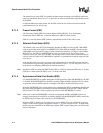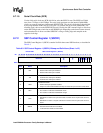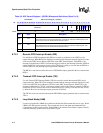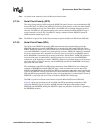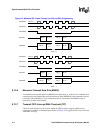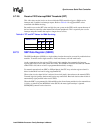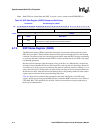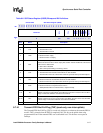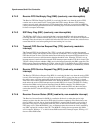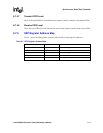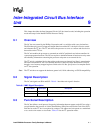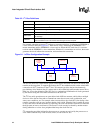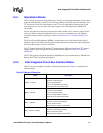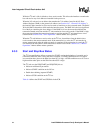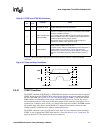
8-18 Intel® PXA26x Processor Family Developer’s Manual
Synchronous Serial Port Controller
8.7.4.2 Receive FIFO Not Empty Flag (RNE) (read-only, non-interruptible)
The Receive FIFO Not Empty Flag (RNE) is a read-only bit that is set when the receive FIFO
contains one or more entries and is cleared when the FIFO is empty. Because CPU interrupt
requests are only made when the receive FIFO threshold has been met or exceeded, the RNE bit
can be polled when programmed I/O removes remaining bytes of data from the receive FIFO. This
bit does not request an interrupt.
8.7.4.3 SSP Busy Flag (BSY) (read-only, non-interruptible)
The SSP Busy (BSY) flag is a read-only bit that is set when the SSP is actively transmitting or
receiving data and is cleared when the SSP is idle or disabled (SSE=0). This bit does not request an
interrupt. Since the software can read this bit before the SSP starts to transmit data, software must
ensure that this bit is set before polling the bit and waiting for it to clear.
8.7.4.4 Transmit FIFO Service Request Flag (TFS) (read-only, maskable
interrupt)
The Transmit FIFO Service Request Flag (TFS) is a read-only bit that is set when the transmit
FIFO is nearly empty and requires service to prevent an underrun. TFS is set any time the transmit
FIFO has the same or fewer valid data entries than indicated by the transmit FIFO threshold. It is
cleared when it has more valid data entries than the threshold value. When the TFS bit is set, an
interrupt request is made unless the transmit FIFO interrupt request enable (TIE) bit is cleared. The
TFS bit’s setting indicates whether a DMA service has been requested by the DMA controller. The
DMA request cannot be masked by the TIE bit. After the CPU or the DMA fills the FIFO such that
it exceeds the threshold, the TFS flag (and the service request or interrupt) is automatically cleared.
8.7.4.5 Receive FIFO Service Request Flag (RFS) (read-only, maskable
interrupt)
The Receive FIFO Service Request Flag (RFS) is a read-only bit that is set when the receive FIFO
is nearly filled and requires service to prevent an overrun. RFS is set any time the receive FIFO has
the same or more valid data entries than indicated by the receive FIFO Threshold. It is cleared
when it has fewer entries than the threshold value. When the RFS bit is set, an interrupt request is
made unless the receive FIFO interrupt request enable (RIE) bit is cleared. The RFS bit’s setting
indicates that DMA service has been requested from the DMA controller. This DMA request
cannot be masked by the RIE bit. After the CPU or DMA reads the FIFO such that it has fewer
entries than the RFT value, the RFS flag (and the service request or interrupt) is automatically
cleared.
8.7.4.6 Receiver Overrun Status (ROR) (read/write, non-maskable interrupt)
The Receiver Overrun Status bit (ROR) is a read/write bit that is set when the receive logic
attempts to place data into the receive FIFO after it has been completely filled. Each time a new
piece of data is received, the set signal to the ROR bit is asserted and the newly received data is
discarded. This process is repeated for each new piece of data received until at least one empty
FIFO entry exists. When the ROR bit is set, an interrupt request that cannot be locally masked by
any SSPC register bit is made to the CPU. The ROR bit’s setting does not generate any DMA
service request. Writing a “1” to this bit resets ROR status and its interrupt request. Writing a “0”
does not affect ROR status.



